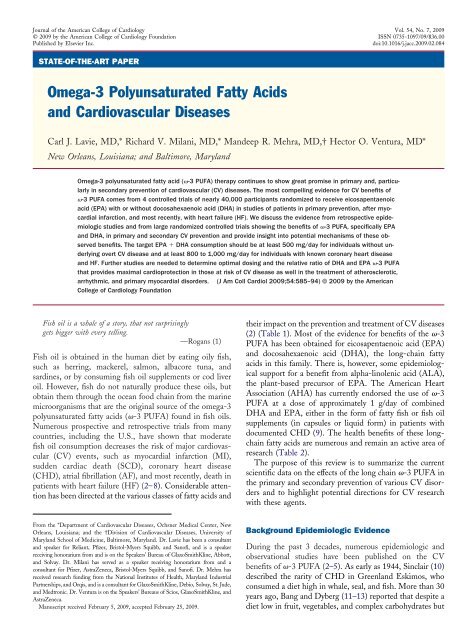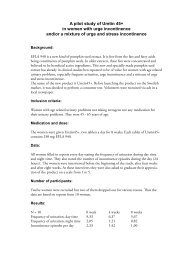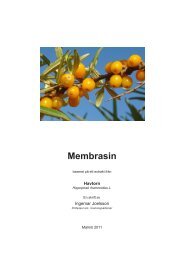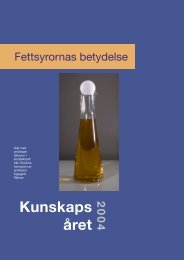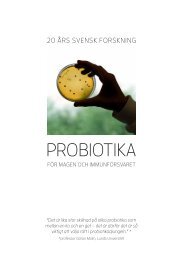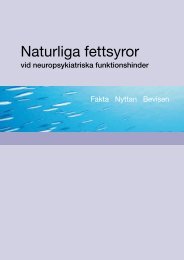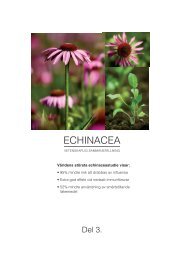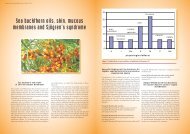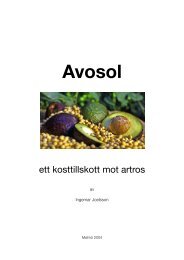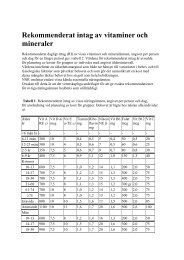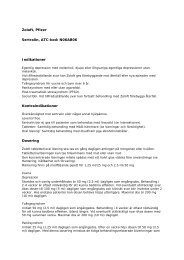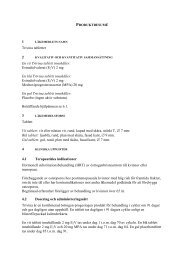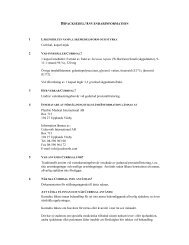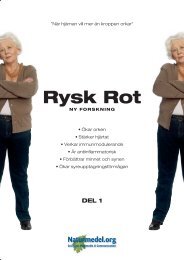Omega-3 Polyunsaturated Fatty Acids and Cardiovascular Diseases
Omega-3 Polyunsaturated Fatty Acids and Cardiovascular Diseases
Omega-3 Polyunsaturated Fatty Acids and Cardiovascular Diseases
Create successful ePaper yourself
Turn your PDF publications into a flip-book with our unique Google optimized e-Paper software.
JACC Vol. 54, No. 7, 2009August 11, 2009:585–94Lavie et al.<strong>Omega</strong>-3 PUFA <strong>and</strong> CV <strong>Diseases</strong>587Figure 1Fish Oil <strong>and</strong> Post-MI PrognosisEarly benefit of omega-3 polyunsaturated fatty acid (-3 PUFA) therapy on total mortality, sudden death, coronary heart disease (CHD) mortality, <strong>and</strong> cardiovascularmortality. Probability measurements represent relative risk (95% confidence interval). Reprinted, with permission, from Marchioli et al. (18). MI myocardial infarction.In another trial, the JELIS (Japan EPA Lipid InterventionStudy) trial (7), 18,645 patients (14,981 in primary prevention<strong>and</strong> 3,664 in secondary prevention) with hypercholesterolemia(70% women) were r<strong>and</strong>omized to statin alone or statin <strong>and</strong>highly purified EPA 1,800 mg/day. At the end of the 5-yearstudy, those r<strong>and</strong>omized to EPA had a 19% reduction in majorCV events (Fig. 2). Unlike the GISSI-Prevenzione study,however, which included lower doses of EPA but also DHA,Figure 2EPA in Primary PreventionEicosapentaenoic acid (EPA) (1.8 g/day) reduced the incidence of majoradverse coronary events in the JELIS (Japan EPA Lipid Intervention Study) trialby 19%. Reprinted, with permission, from Yokoyama et al. (7). CI confidenceinterval.the moderate dose of EPA alone in the JELIS trial was notassociated with a reduction in SCD (possibly because of thevirtual absence of SCD in this cohort).In combination, the DART, GISSI-Prevenzione, <strong>and</strong>JELIS trials indicated that -3 PUFA lower CV risk inboth primary <strong>and</strong> secondary prevention settings. However,it should be noted that other studies have not shownfavorable results. For example, a trial by Burr et al. (19)suggested that patients with angina treated with fish oilcapsules seem to have a higher risk of SCD than untreatedcontrol subjects. Von Schacky <strong>and</strong> Harris (20) criticized thistrial as being suboptimally conducted or reported, thus theresults are questionable. Also, a Norwegian study by Nilsenet al. (21) did not show a benefit of -3 PUFA supplementationin post-MI patients. Why treatment with -3 PUFAwas successful in Japan but not in Norway, both populationswith a high background intake of -3 PUFA, is not clear,but the much higher number in the former (n 18,645)versus the latter (n 300) was likely a factor. Finally, arecent trial (the OMEGA trial) was presented that assessed-3 PUFA (460 mg EPA 380 mg DHA per day) for 1year in 3,851 patients 3 to 14 days after acute MI from 104centers in Germany (22). In these vigorously treated patients(85% to 95% usage of aspirin, clopidogrel, statins,beta-blockers, <strong>and</strong> angiotensin-converting enzyme inhibitors),the arrhythmic event rate <strong>and</strong> total mortality were only0.7% <strong>and</strong> 3.7%, respectively, in the placebo group, <strong>and</strong> thistrial showed no benefit of EPA/DHA on any of the primary
588 Lavie et al. JACC Vol. 54, No. 7, 2009<strong>Omega</strong>-3 PUFA <strong>and</strong> CV <strong>Diseases</strong> August 11, 2009:585–94or secondary end points. Although this study was probablyunderpowered to adequately determine the effects of thistherapy in secondary CHD prevention, these preliminaryresults certainly raise the possibility that -3 PUFA may notprovide additional short-term protection to low-risk patientsreceiving extensive modern post-MI therapies.This review does not focus on ALA, which is found inabundance in flaxseed <strong>and</strong> to a lesser extent in canola <strong>and</strong>olive oil, walnuts, <strong>and</strong> other tree nuts, as well as traceamounts in green leafy vegetables. As the only dietary sourceof -3 PUFA, ALA is considered to be inadequate becausehumans convert typically 5% of ALA to EPA <strong>and</strong> evenless to DHA (23). In some (but not all) epidemiologicstudies, ALA has been inversely associated with CV events(3,24). For example, in a recent study from a Costa Ricanpopulation, ALA intake <strong>and</strong> blood levels predicted a betterprognosis, independent of fish <strong>and</strong> EPA/DHA levels, in apost-MI population (25). Nevertheless, the overall evidenceis much weaker for ALA than for EPA <strong>and</strong> DHA.Evidence of Benefit in AtherosclerosisSeveral epidemiologic <strong>and</strong> necropsy studies have indicated thatJapanese men have significantly lower levels of atherosclerosisthan Caucasian men residing in the U.S. (26,27). In studiesthat assessed intima-media thickness (IMT) <strong>and</strong> coronaryartery calcification (CAC), both independent predictors of CVevents, Japanese men have lower grades of atherosclerosis th<strong>and</strong>o the Caucasians residing in the U.S. (26). Recently,Seikikawa et al. (27) haveconsideredthe“Japanesefactor”in281 Japanese men born <strong>and</strong> living in Japan, 281 Japanese menliving in the U.S., <strong>and</strong> 360 Caucasian men born <strong>and</strong> living inthe U.S. The overall results suggested that Japanese men hadthe lowest level of atherosclerosis, whereas Japanese in the U.S.<strong>and</strong> Caucasians had similar levels. The -3 PUFA serum levelscorrelated inversely with IMT in the Japanese men, but CACburden was not related to -3 PUFA status in any cohort.Nevertheless, the differences between carotid IMT <strong>and</strong> CAClevels in the 3 groups, which persisted after adjustment for thetraditional CHD risk factors, disappeared after adjustments forserum -3 PUFA content, suggesting that very high intake ofmarine-derived -3 PUFA has antiatherosclerotic effects(14,27). Despite these promising results, other evidence suggeststhat a very high intake of shortening <strong>and</strong> other saturatedfats in the Westernized diet may overwhelm the beneficialeffects of high -3 PUFA intake in Alaskan Natives <strong>and</strong> theJapanese (14).Evidence in ArrhythmiasWe (28) <strong>and</strong>others(29) havereviewedtheantiarrhythmiceffects of -3 PUFA. Chronic imbalance of the autonomicnervous system, with increases in symptomatic <strong>and</strong>/or decreasesin parasympathetic tone, increases the risk of major CVevents <strong>and</strong> dysrhythmias (3,28). Several r<strong>and</strong>omized controlledtrials show that -3 PUFA improve sympathovagal balance.Christenen et al. (30) foundthatpatientspost-MI<strong>and</strong>withimpaired systolic function had improvements in heart ratevariability after 4.3 g/day of EPA <strong>and</strong> DHA for 12 weeks.Using lower doses of -3 PUFA, O’Keefe et al. (31) showedsignificant reductions in resting heart rate, 1-min heart raterecovery after exercise, <strong>and</strong> improvement in heart rate variabilityafter 4 months of modest-dose -3 PUFA (810 mg/dayEPA <strong>and</strong> DHA). Geelen et al. (32) showedthat14weeksofmoderate-dose -3 PUFA (1,260 mg/day EPA <strong>and</strong> DHA)reduced the average heart rate in patients with complexventricular arrhythmias. A large study of 5,096 men <strong>and</strong> womenby Mozaffarian et al. (33)showedthathighdietaryfishintakewasassociated with lower heart rate, slower atrial ventricular conduction,<strong>and</strong> a substantially lower likelihood of having a prolongedQT interval. In aggregate, these studies suggest that -3PUFA have benefits in improving autonomic function.Current research suggests that -3 PUFA may prevent fatalarrhythmias via their ability to inhibit fast, voltage-dependentsodium channels <strong>and</strong> L-type calcium channels (28). Furthermore,DHA has been shown to directly inhibit the delayedrectifierpotassium channel, which is responsible for the depolarizationphase of ventricular <strong>and</strong> atrial cardiac potentials.Although the relative effects of DHA <strong>and</strong> EPA remainuncertain, DHA’s effect on atrial <strong>and</strong> ventricular repolarizationraises the possibility that DHA could provide greater protectionagainst dysrhythmias, a fact that is supported by thebeneficial effects of combined EPA <strong>and</strong> DHA against SCD inthe GISSI-Prevenzione trial (6) butnotnotedwithhigherdoses of EPA alone in the JELIS trial (7).Although -3 PUFA seem to be effective in reducing SCDin post-MI <strong>and</strong> in CHD patients with LV dysfunction(6,15–17), 3 trials using -3 PUFA in patients with implantablecardioverter-defibrillators (ICDs) have shown mixed results(34–36). The initial trial received substantial negativepublicity when a subgroup of -3 PUFA–treated patients hadmore frequent ICD discharges compared with the placebogroup, suggesting that these supplements may be proarrhythmicin certain patients (34). In another trial, Leaf et al. (35)found a trend for lower risk for the combined end point ofICD discharge death from any cause (28%; p 0.057) inthe group r<strong>and</strong>omized to -3 PUFA, with risk reduction ofclose to 40% (p 0.03) when adjusting for probable episodesof malignant arrhythmias <strong>and</strong> compliance. A third trial (<strong>and</strong>the largest) showed no significant differences between -3PUFA <strong>and</strong> placebo in patients with ICD, but in a subgroupwith prior MI, the -3 PUFA group had a trend towardbenefit (p 0.09) (36). These trials used 1.8, 2.6, <strong>and</strong> 0.8 g of-3 PUFA daily, respectively. The GISSI-HF study, discussedlater, did not show any benefits against SCD with thesame dose of -3 PUFA used in the GISSI-Prevenzionestudy, raising the possibility that -3 PUFA may not benefitSCD risk with large populations with significant LV dysfunction.Perhaps the most significant antiarrhythmic effects, however,have been noted in studies of AF (28). Mozaffarianet al. (37) showed a 30% lower risk of AF over a 12-yearfollow-up in patients who consumed high quantities ofnonfried fish. However, the Rotterdam study (38) found no
JACC Vol. 54, No. 7, 2009August 11, 2009:585–94Lavie et al.<strong>Omega</strong>-3 PUFA <strong>and</strong> CV <strong>Diseases</strong>589Figure 3Fish Intake <strong>and</strong> CHFSurvival free of congestive heart failure (CHF) according to consumption of tunaor other fish that are high in eicosapentaenoic acid <strong>and</strong> docosahexaenoic acid.Reprinted, with permission, from Mozaffarian et al. (41).such correlation. Two studies in patients undergoing coronaryartery bypass grafting have suggested 50% reductionsin the development of post-surgical AF in patients pretreatedwith -3 PUFA with the number needed to treatbeing only 5.5 in one study (39); one of the studies alsoshowed significant reduction in days hospitalized (39,40).Whether these benefits are caused by antiarrhythmic effects,benefits on autonomic tone, or even anti-inflammatoryeffects is impossible to determine from these trials. However,these trials point out the potential benefits of -3PUFA in the current epidemic of AF.Evidence of Benefit in HFRecently, the potential benefits of -3 PUFA have beenextended to the prevention <strong>and</strong> treatment of HF. The <strong>Cardiovascular</strong>Health Study, involving 4,738 men <strong>and</strong> women65 years of age, found an inverse association of baked orbroiled fish intake <strong>and</strong> incident congestive HF (Fig. 3) (41).This result was supported by recent data from the ARIC(Atherosclerosis Risk in Community) study, showing an inverserelationship between -3 PUFA intake <strong>and</strong> incident HFin women (42). A recent study by Yamagishi et al. (43) inaprospective study of nearly 60,000 Japanese followed up fornearly 13 years showed an inverse association between fish <strong>and</strong>-3 PUFA consumption <strong>and</strong> CV mortality, especially for HF.These results are particularly striking in a society with a comparativelyhigh intake of fish <strong>and</strong> background -3 PUFA intake.Confirmatory evidence was recently presented <strong>and</strong> publishedin the GISSI-HF trial (8), a large, factorial, placebocontrolledtrial of nearly 7,000 patients with class II to IVHF who were r<strong>and</strong>omized to 1 g of -3 PUFA (1 highlyconcentrated fish oil capsule, Lovaza, containing 850 to 882mg of EPA DHA), rosuvastatin (10 mg), both, or dualplacebo. This large <strong>and</strong> well-done study showed a statisticallysignificant benefit of the prescription -3 PUFA (Fig.4), including reduction in total mortality (9%; p 0.05)<strong>and</strong> total mortality or hospitalizations for CV diseases(8%; p 0.01). Although these benefits seem to be onlymodest, they translate into 56 patients needing to be treatedfor 4 years to avoid 1 death or hospital CV admission.Importantly, this therapy was safe <strong>and</strong> well tolerated, <strong>and</strong> theimprovements in clinical outcomes were additive to that ofother well-established HF therapies, including beta-blockers,angiotensin-converting enzyme inhibitor/angiotensin receptorblockers, <strong>and</strong> aldosterone receptor blockers. Unlike the GISSI-Prevenzione trial (6), which used the same dose of concentratedprescription -3 PUFA, prevention of SCD did notseem to explain the benefits of fish oil in HF, nor did HFhospitalizations account for these benefits.Figure 4Fish Oil <strong>and</strong> Heart Failure SurvivalKaplan-Meier curves for time to all-cause death (A) <strong>and</strong> for time to all-cause death or admission to hospital for cardiovascular reasons (B). Reprinted, with permission,from the GISSI-HF Investigators (8). *Estimates were calculated with a Cox proportional hazards model, with adjustment for admission to the hospital for heart failure inthe previous year, previous pacemaker, <strong>and</strong> aortic stenosis. CI confidence interval; HR hazard ratio; -3 PUFA omega-3 polyunsaturated fatty acids.
590 Lavie et al. JACC Vol. 54, No. 7, 2009<strong>Omega</strong>-3 PUFA <strong>and</strong> CV <strong>Diseases</strong> August 11, 2009:585–94Questions remain regarding the mechanisms responsible forthe -3 PUFA effects in HF. In addition to the establishedeffects of fish oil therapy, both EPA <strong>and</strong> DHA are potentactivators of peroxisome proliferator-activator receptor(PPAR)-alpha (found in the heart) <strong>and</strong> PPAR-gamma (44).Although fatty acids are classically viewed as an energy substratein the heart, they are also endogenous lig<strong>and</strong>s for PPARs<strong>and</strong> regulate the expression of genes encoding key proteinscontrolling myocardial fatty acid uptake <strong>and</strong> metabolism (45).Stanley et al. (46) haveshownthatahigh-fatdietincreasesplasma free fatty acid concentration, activating PPAR-alpha inthe heart <strong>and</strong> stimulating expression of key mitochondrialproteins involving fatty acid oxidation. Duda et al. (47)observed that dietary -3 PUFA from fish oil (1.6 g EPA DHA) significantly increases serum levels of the cardioprotectiveadipokine adiponectin in rats subjected to either shamtreatment or hypertension induced by abdominal aortic b<strong>and</strong>ing.Most importantly, the increase in adiponectin correspondedto significant attenuation of LV hypertrophy <strong>and</strong>correlated with decreased LV end-systolic volume. Recentevidence suggests that lig<strong>and</strong> activation of PPAR-gamma byEPA <strong>and</strong>/or DHA up-regulates adiponectin <strong>and</strong> suppressionof inflammatory cytokines (48–50), which could improvecardiac structure <strong>and</strong> function in HF (51,52). Thus, importantcardiac remodeling effects may underlie the observed clinicalbenefits of fish oils in HF.In a small 18-week pilot study of 14 patients with class IIIIto IV HF r<strong>and</strong>omized to 5.1 g/day of EPA <strong>and</strong> DHA, weshowed marked improvements in inflammatory cytokines (e.g.,tumor necrosis factor alpha <strong>and</strong> interleukin-1), <strong>and</strong> percentbody fat in advanced HF, suggesting that fish oil may bebeneficial in decreasing inflammation <strong>and</strong> cachexia in advancedHF (53). This suggests a potentially novel therapeutic approachin the late stages of HF. In addition, our study raisesthe issue of the dose needed to obtain maximal clinical benefitsin patients with HF. Both the GISSI-HF study (8) <strong>and</strong>theJapan epidemiological study (43) likewiseraisedthepossibilitythat pharmacological doses may be needed in patients withHF. Animal studies in cardiac remodeling suggest the need forhigher doses as well. Therefore, further studies are neededdetermining not only the optimal dose of -3 PUFA protectionin different stages of HF but also the underlying mechanismsaccountable for their benefits. However, at present, weagree with Fonarow’s (54) assertionthat-3 PUFA supplementation“should join the short list of evidence-based lifeprolongingtherapy for HF.”Evidence for Benefit in HyperlipidemiaThe U.S. Food <strong>and</strong> Drug Administration (FDA) has approvedan -3 PUFA ethyl ester formulation (Lovaza), at a dosageof 4 g/day for the treatment of very high triglyceride levels(500 mg/dl) (55–57). It is well established that -3 PUFAlower plasma triglyceride concentrations (20,58,59). Themechanism for these lipid-lowering effects seems to involveactivation of PPARs. Although fatty acids are classicallyobserved as an energy substrate, they are also endogenouslig<strong>and</strong>s for PPARs <strong>and</strong> regulate the expression of genesencoding key proteins controlling fatty acid uptake <strong>and</strong>metabolism <strong>and</strong> the formation of very-low-density lipoproteinscarrying triglycerides in the liver (60,61). Although theexact transcriptional mechanism by which fish oils improvelipid levels is not completely understood, -3 PUFA doreduce hepatic synthesis of triglycerides <strong>and</strong> increase hepaticfatty acid beta-oxidation. The triglyceride-lowering doses ofDHA <strong>and</strong> EPA is 3 to 4 g/day. This dose typically reducestriglyceride levels by 30% to 40% (59) <strong>and</strong> has been shownto reduce severely elevated triglyceride levels (500 mg/dl)by 45%, along with reductions in non–high-density lipoproteincholesterol by 14% with a 9% increase in highdensitylipoprotein cholesterol (62). When added to baselinestatin therapy in patients with triglyceride levelsbetween 200 <strong>and</strong> 499 mg/dl, this dosage of -3 PUFAlowers triglyceride levels by close to 30% (63). Generally,there are no significant improvements in levels of lowdensitylipoprotein (LDL) cholesterol with fish oil therapy,especially in patients with elevated triglyceride levels, whooften notice increases between 5% <strong>and</strong> 50% (depending onthe severity of the hypertriglyceridemia <strong>and</strong> baseline LDLlevels) (62). Interestingly, in the JELIS study, moderatedoses of EPA resulted in 10% reductions in LDL cholesterolbeyond that produced by low-dose statins (7). Nevertheless,even when LDL cholesterol increases with -3PUFA, as it can with fibrates <strong>and</strong> occasionally with niacin,-3 PUFA–enriched LDL has been reported to be larger<strong>and</strong> fluffier (pattern A), which is potentially less atherogenicthan the smaller, denser (pattern B) LDL particles (64).Although typically more expensive than dietary supplements,the capsular form is a st<strong>and</strong>ardized prescriptionpreparation (Lovaza, 4 g) with FDA-approved safety <strong>and</strong>efficacy data <strong>and</strong> is the most concentrated source of DHA<strong>and</strong> EPA available.Additional Mechanisms<strong>and</strong> Optimal DHA/EPA RatiosAdetaileddiscussionofallofthepotentialmechanismsof-3PUFA <strong>and</strong> CV diseases (summarized in Table 2)isbeyondthescope of this review. It appears that -3 PUFA confer CVbenefits largely through DHA <strong>and</strong> EPA enrichment of membranephospholipids (65). In addition to mechanisms discussedabove, -3 PUFA produces vasodilation, reduces blood pressure(31,66), improves arterial <strong>and</strong> endothelial function (67),<strong>and</strong> reduces platelet aggregation (68). The antiplatelet, antiinflammatory,<strong>and</strong> triglyceride-lowering effects of -3 PUFA(Fig. 5)(69)requirerelativelyhigherdosesofDHA<strong>and</strong>EPA(e.g., 3 to 4 g/day), whereas some of the antiarrhythmic effects,reduction of SCD, <strong>and</strong> improvement in HF can be achieved atlower doses (500 to 1,000 mg/day). Nevertheless, higher dosesmay be even more effective in HF, as discussed previously.Although the effects of -3 PUFA on C-reactive proteinlevels have been inconsistent (70), these agents have been
JACC Vol. 54, No. 7, 2009August 11, 2009:585–94Lavie et al.<strong>Omega</strong>-3 PUFA <strong>and</strong> CV <strong>Diseases</strong>591Figure 5Fish Oil Dosing <strong>and</strong> <strong>Cardiovascular</strong> ImpactSchema of potential dose responses <strong>and</strong> time courses for altering clinical events of physiologic effects of fish or fish oil intake.BP blood pressure; DHA docosahexaenoic acid; EPA eicosapentaenoic acid. Reprinted, with permission, from Mozaffarian <strong>and</strong> Rimm (69).shown to suppress production of pro-inflammatory cytokinessuch as interleukin-1B, interleukin-6, <strong>and</strong> tumornecrosis factor-alpha (71). When administered to obesepatients, 1.8 g of EPA increased the levels of adiponectin,which can reduce inflammation <strong>and</strong> improve insulin sensitivity(72), in addition to the potential beneficial HF effectsdiscussed earlier. Although benefits on the autonomicnervous system are well established <strong>and</strong> are reviewedearlier, studies in patients undergoing heart transplantationsuggest that -3 PUFA can reduce heart rateindependently of vagal activation (73), in addition toreducing mean arterial pressure <strong>and</strong> systemic vascularresistance by 25% <strong>and</strong> reducing LV hypertrophy <strong>and</strong>improving diastolic function in heart transplantationpatients with cyclosporine-induced hypertension (66).The optimal doses <strong>and</strong> ratios of DHA to EPA aredifficult to decipher. Both DHA <strong>and</strong> EPA are present inmost fish, particularly oily ones, generally in a 2:1 ratio(Table 3) (3,74), whereas fish oils typically have a ratio of2:3 or lower (3). Although feeding pure DHA can raiseEPA levels to a small extent (75), the reverse is not true(76). Additionally, DHA is far more abundant than EPAin the myocardium (68). As reviewed earlier, DHA aloneor in combination with EPA may be more important forprotection against dysrhythmias <strong>and</strong> SCD than EPAalone. Although the beneficial effects on dysrhythmiasseem to occur at lower doses, the relative risk of SCD hasbeen shown to be related with baseline blood levels of-3 PUFA (Fig. 6) (3,77) <strong>and</strong>, as reviewed earlier,protection against CHD was also inversely related withtissue levels of EPA <strong>and</strong>, more so, with DHA levels (15).In addition, other surrogate CV markers (arterial pressure,endothelial relaxation <strong>and</strong> attenuated vascular relaxation,<strong>and</strong> lipoproteins) may be more improved with highdoses of DHA than with similar doses of EPA (78).Fish Table Content 3 Fish of EPA Content <strong>and</strong> DHA of EPA <strong>and</strong> DHATunaTypeDHA(g/100 g)EPA(g/100 g)DHA <strong>and</strong> EPA(g/100 g)RatioDHA/EPABluefin 1.141 0.363 1.504 3.1:1.0Light, canned in water 0.223 0.047 0.270 4.8:1.0Albacore, canned in water 0.629 0.233 0.862 2.7:1.0SalmonAtlantic, farmed 1.457 0.690 2.147 2.1:1.0Atlantic, wild 1.429 0.411 1.840 3.5:1.0Chinook 0.727 1.010 1.737 1.0:1.4Sockeye 0.700 0.530 1.230 1.3:1.0Mackerel, Atlantic 0.699 0.504 1.203 1.4:1.0Herring, Atlantic 1.105 0.909 2.014 1.2:1.0TroutRainbow, farmed 0.820 0.334 1.154 2.5:1.0Rainbow, wild 0.520 0.468 9.988 1.1:1.0Halibut 0.374 0.091 0.465 4.1:1.0Cod 0.154 0.004 0.158 38.5:1.0Haddock 0.162 0.076 0.238 2.1:1.0CatfishChannel, farmed 0.128 0.049 0.177 2.6:1.0Channel, wild 0.137 0.100 0.237 1.4:1.0Swordfish 0.681 0.087 0.768 7.8:1.0Grouper 0.213 0.035 0.248 6.1:1.0Shrimp 0.144 0.171 0.315 1.0:1.2Data from the USDA Agricultural Research Service (74) <strong>and</strong> reprinted, with permission, from Lee etal. (3).Abbreviations as in Table 1.
592 Lavie et al. JACC Vol. 54, No. 7, 2009<strong>Omega</strong>-3 PUFA <strong>and</strong> CV <strong>Diseases</strong> August 11, 2009:585–94RecommendationsFigure 6<strong>Omega</strong>-3 Blood Levels <strong>and</strong> SCDRelative risk of sudden cardiac death (SCD) according to baseline blood levelsof omega-3 fatty acids as percentage of total fatty acids. Data from Albertet al. (77). Reprinted, with permission, from Lee et al. (3).Safety <strong>and</strong> Adverse EffectsThe most commonly observed adverse effects of -3 PUFAsupplementation are nausea, gastrointestinal upset, <strong>and</strong>“fishy” burp. Prolonged bleeding times, as noted in Greenl<strong>and</strong>Eskimos <strong>and</strong> when feeding “hyper-Eskimo” doses of-3 PUFA (e.g., over 20 g/day) to normal volunteers,usually remain in the high end of the normal range (3,10).These observations, however, raised concerns that higherintakes will increase hemorrhagic complications. However,Harris (79), in a comprehensive review, concluded thatthere was no increased risk of clinically significant bleedingnoted with -3 PUFA doses of up to 7 g of combined DHA<strong>and</strong> EPA per day, even when combined with antiplatelettherapy or warfarin.One of the major concerns, not about EPA <strong>and</strong> DHAper se, but about diets high in oily fish, is the consumptionof contaminants, namely methyl mercury. For thisreason, the FDA has advised children <strong>and</strong> pregnant ornursing women to specifically avoid those fish with apotentially high content of mercury, such as swordfish,tile fish, king mackerel, <strong>and</strong> shark (80). Nevertheless, astudy of nearly 12,000 British women during theirpregnancy <strong>and</strong> beyond found that women who exceededthe U.S. FDA recommendation for fish intake actuallyhad offspring with better cognitive <strong>and</strong> behavioral developmentthan offspring of women who consumed less fishduring pregnancy (81). A large meta-analysis by Mozaffarian<strong>and</strong> Rimm (82) alsoshowedthefavorablerisk-tobenefitratio (1:400) associated with a high consumptionof fish. Importantly, the most commonly consumeddietary sources of -3 PUFA, such as salmon, sardines,trout, oysters, <strong>and</strong> herring, are quite low in mercury (3).Because mercury is water soluble <strong>and</strong> protein bound, it ispresent in the muscle of the fish but not in the oil.Therefore, fish oil supplements should contain negligibleamounts of mercury (83).The current AHA dietary guidelines recommend combinedEPA <strong>and</strong> DHA in a dose of approximately 1,000mg/day in patients with CHD (9). This dose is largelydetermined from the GISSI-Prevenzione study, in whichadoseof850mgwasused.ForthoseindividualswithoutCHD, the AHA recommends 2 oily fish meals per week.This has been shown to be equivalent to about 500mg/day of combined EPA <strong>and</strong> DHA, the intake associatedwith the lowest risk for CHD death in several U.S.prospective cohort studies (84). Several other majororganizations, including the National Cholesterol EducationProgram (85), the World Health Organization(86), the European Society of Cardiology (87), theUnited Kingdom Scientific Advisory Committee in Nutrition(88), <strong>and</strong> the American Diabetes Association (89),have all provided guidelines that address increasingconsumption of fish. Based on the GISSI-HF studyresults, we believe that these recommendations, similar toCHD, should also be extended to patients with HF (e.g.,approximately 800 to 1,000 mg of combined EPA/DHAdaily) (8,54). In patients with hypertriglyceridemia, moderateto high doses of -3 PUFA (Lovaza, 4 g/day) is anFDA-approved therapy (55–57,64), <strong>and</strong> this therapy canbe safely combined with any other lipid therapies (statins,fibrates, niacin, <strong>and</strong> so on). Further studies are neededthat will determine the optimal dosing in various populations,especially those with HF, as well as the effects ofvarious doses on the primary <strong>and</strong> secondary reduction ofAF <strong>and</strong> more detailed mechanisms responsible for thebenefits noted. Further studies will be needed to addressthe potential benefits of assessing blood levels of -3PUFA to determine its role in dosing adjustments <strong>and</strong> itsvalue in CV protection (90). Finally, studies are neededto determine the optimal mixture of DHA relative toEPA in various populations, as well as in light of therecent OMEGA trial (22), to determine the role of -3PUFA in maximally treated contemporary post-MI patientsor other patients with relatively low-risk CHD.ConclusionsConvincing evidence from extensive research over the past 3decades points out the potential beneficial effects of -3PUFA in primary prevention, CHD <strong>and</strong> post-MI, SCD,HF, atherosclerosis, <strong>and</strong> AF. Based on the growing evidencefor the benefits of fish oils, we agree that this storyrepresents a “fish tale with growing credibility.” We alsoagree with Rogans’ comment from over 20 years ago that“fish oil is a whale of a story, that not surprisingly gets biggerwith every telling” (1).AcknowledgmentThe authors thank Dr. William S. Harris for helpful adviceduring early drafts of this review.
JACC Vol. 54, No. 7, 2009August 11, 2009:585–94Lavie et al.<strong>Omega</strong>-3 PUFA <strong>and</strong> CV <strong>Diseases</strong>593Reprint requests <strong>and</strong> correspondence: Dr. Carl J. Lavie, CardiacRehabilitation, Ochsner Medical Center, 1514 Jefferson Highway,New Orleans, Louisiana 70121-2483. E-mail: clavie@ochsner.org.REFERENCES1. Rogans JA. More on fish oil. N Engl J Med 1987;316:624–8.2. Lavie CJ, Milani RV. Fish oils. In: Messerli FH, editor. <strong>Cardiovascular</strong>Drug Therapy. Philadelphia: Saunders, 1996:1608–13.3. Lee JH, O’Keefe JH, Lavie CJ, Marchioli R, Harris WS. <strong>Omega</strong>-3fatty acids for cardioprotection. Mayo Clin Proc 2008;83:324–32.4. Kromhout D, Bosschieter EB, de Lezenne Coul<strong>and</strong>er C. The inverserelation between fish consumption <strong>and</strong> 20-year mortality from coronaryheart disease. N Engl J Med 1985;312:1205–9.5. Albert CM, Hennekens CH, O’Donnell CJ, et al. Fish consumption<strong>and</strong> risk of sudden cardiac death. JAMA 1998;279:23–8.6. Dietary supplementation with n-3 polyunsaturated fatty acids <strong>and</strong>vitamin E after myocardial infarction: results of the GISSI-Prevenzione trial Gruppo Italiano per lo Studio della Sopravvivenzanell’Infarto miocardico [errata in Lancet 2001;357:642 <strong>and</strong> Lancet2007;369:106]. Lancet 1999;354:447–55.7. Yokoyama M, Origasa H, Matsuzaki M, et al. Effects of eicosapentaenoicacid on major coronary events in hypercholesterolaemic patients(JELIS): a r<strong>and</strong>omised open-label, blinded endpoint analysis[published correction appears in Lancet 2007;370:220]. Lancet 2007;369:1090–8.8. GISSI-HF Investigators. Effect of n-3 polyunsaturated fatty acids inpatients with chronic heart failure (the GISSI-HF trial): a r<strong>and</strong>omised,double-blind, placebo-controlled trial. Lancet 2008;372:1223–30.9. Kris-Etherton PM, Harris WS, Appel LJ, for the American HeartAssociation Nutrition Committee. Fish consumption, fish oil,omega-3 fatty acids, <strong>and</strong> cardiovascular disease [published correctionappears in Circulation 2003;107:512]. Circulation 2002;106:2747–57.10. Sinclair HM. The diet of Canadian Indians <strong>and</strong> Eskimos. Proc NutrSoc 1953;12:69–82.11. Bang HO, Dyerberg J. Plasma lipids <strong>and</strong> lipoproteins in Greenl<strong>and</strong>icwest coast Eskimos. Acta Med Sc<strong>and</strong> 1972;192:85–94.12. Bang HO, Dyerberg J. Lipid metabolism <strong>and</strong> ischemic heart disease inGreenl<strong>and</strong> Eskimos. Adv Nutr Res 1980;3:1–22.13. Dyerberg J, Bang HO, Hjorne N. <strong>Fatty</strong> acid composition of theplasma lipids in Greenl<strong>and</strong> Eskimos. Am J Clin Nutr 1975;28:958–66.14. William H. <strong>Omega</strong>-3 fatty acids: the “Japanese” factor? J Am CollCardiol 2008;52:425–7.15. Harris WS, Poston WC, Haddock CK. Tissue n-3 <strong>and</strong> n-6 fatty acids<strong>and</strong> risk for coronary heart disease events. Atherosclerosis 2007;193:1–10.16. Burr ML, Fehily AM, Gilbert JF, et al. Effects of changes in fat, fish,<strong>and</strong> fibre intakes on death <strong>and</strong> myocardial reinfarction: Diet AndReinfarction Trial (DART). Lancet 1989;2:757–61.17. Macchia A, Levantesi G, Franzosi MG, et al. Left ventricular systolicdysfunction, total mortality, <strong>and</strong> sudden death in patients withmyocardial infarction treated with n-3 polyunsaturated fatty acids. EurJ Heart Fail 2005;7:904–9.18. Marchioli R, Barzi F, Bomba E, et al., for the GISSI-PrevenzioneInvestigators. Early protection against sudden death by n-3 polyunsaturatedfatty acids after myocardial infarction: time-course analysis ofthe results of the Gruppo Italiano per lo Studio della Sopravvivenzanell’Infarto Miocardico (GISSI)-Prevenzione. Circulation 2002;105:1897–903.19. Burr ML, Ashfield-Watt PA, Dunstan FD, et al. Lack of benefit ofdietary advice to men with angina: results of a controlled trial. EurJ Clin Nutr 2003;57:193–200.20. von Schacky C, Harris WS. <strong>Cardiovascular</strong> benefits of omega-3 fattyacids. Cardiovasc Res 2007;73:310–5.21. Nilsen DW, Albrektsen G, L<strong>and</strong>mark K, Moen S, Aarsl<strong>and</strong> T, WoieL. Effects of a high-dose concentrate of n-3 fatty acids or corn oilintroduced early after an acute myocardial infarction on serum triacylglycerol<strong>and</strong> HDL cholesterol. Am J Clin Nutr 2001;74:50–6.22. Senges S, for the OMEGA Study Group. R<strong>and</strong>omized trial ofomega-3 fatty acids on top of modern therapy after acute myocardialinfarction: the OMEGA trial. Oral presentation at: Annual ScientificSessions of the American College of Cardiology; March 2009;Orl<strong>and</strong>o, FL.23. Plourde M, Cunnane SC. Extremely limited synthesis of long chainpolyunsaturates in adults: implications for their dietary essentiality <strong>and</strong>use as supplements. Appl Physiol Nutr Metab 2007;32:619–34.24. Wang C, Harris WS, Chung M, et al. n-3 fatty acid from fish orfish-oil supplements, but not [alpha]-linolenic acid, benefit cardiovasculardisease outcomes in primary- <strong>and</strong> secondary-prevention studies:a systematic review. Am J Clin Nutr 2006;84:5–17.25. Campos H, Baylin A, Wilett WC. -linolenic acid <strong>and</strong> risk ofnonfatal acute myocardial infarction. Circulation 2008;118:339–45.26. Seikikawa A, Ueshima H, Kadowaki T, et al. Less subclinicalatherosclerosis in Japanese men in Japan than in white men in theUnited States in the post–World War II birth cohort. Am J Epidemiol2007;165:617–24.27. Seikikawa A, Curb JD, Ueshima H. Marine-derived n-3 fatty acids<strong>and</strong> atherosclerosis in Japanese, Japanese-American, <strong>and</strong> white men: across-sectional study. J Am Coll Cardiol 2008;52:417–24.28. An<strong>and</strong> RG, Alkadri M, Lavie CJ, Milani RV. The role of fish oil inarrhythmia prevention. J Cardiopulm Rehabil 2008;28:92–8.29. Reiffel JA, McDonald A. Antiarrhythmic effects of omega-3 fattyacids. Am J Cardiol 2006;98:501–601.30. Christensen JH, Gustenhoff P, Korup E, et al. Effect of fish oil onheart rate viability in survivors of myocardial infarction: a double blindr<strong>and</strong>omized controlled trial. Br Med J 1996;312:677–8.31. O’Keefe JH Jr., Abuissa H, Sastre A, Steinhaus DM, Harris WS.Effects of omega-3 fatty acids on resting heart rate, heart rate recoveryafter exercise, <strong>and</strong> heart rate viability in men with healed myocardialinfarctions <strong>and</strong> depressed ejection fractions. Am J Cardiol 2006;97:1127–30.32. Geelen A, Brouwer IA, Schouten EG, Maan AC, Katan MB, ZockPI. Effects of n-3 fatty acids from fish on premature ventricularcomplexes <strong>and</strong> heart rate in humans. Am J Clin Nutr 2005;81:416–20.33. Mozaffarian D, Prineas RJ, Stein PK, Siscovick DS. Dietary fish <strong>and</strong>n-3 fatty acid intake <strong>and</strong> cardiac electrocardiographic parameters inhumans. J Am Coll Cardiol 2006;48:478–84.34. Raitt MH, Connor WE, Morris C, et al. Fish oil supplementation <strong>and</strong>risk of ventricular tachycardia <strong>and</strong> ventricular fibrillation in patientswith implantable defibrillators: a r<strong>and</strong>omized controlled trial. JAMA2005;293:2884–91.35. Leaf A, Albert CM, Josephson M, et al. Prevention of fatal arrhythmiasin high-risk subjects by fish oil n-3 fatty acid intake. Circulation2005;112:2762–8.36. Brouwer IA, Zock PL, Camm AJ, et al. Effect of fish oil on ventriculartachyarrhythmia <strong>and</strong> death in patients with implantable cardioverterdefibrillators: the Study on <strong>Omega</strong>-3 <strong>Fatty</strong> <strong>Acids</strong> <strong>and</strong> VentricularArrhythmia (SOFA) r<strong>and</strong>omized trial. JAMA 2006;295:2613–9.37. Mozaffarian D, Psaty BM, Rimm EB, et al. Fish intake <strong>and</strong> risk ofincident atrial fibrillation. Circulation 2004;110:368–73.38. Brouwer IA, Heeringa J, Geleijnse JM, Zock PL, Witteman JC.Intake of very long-chain n-3 fatty acids from fish <strong>and</strong> incidence ofatrial fibrillation. The Rotterdam Study. Am Heart J 2006;151:857–62.39. Calo L, Bianconi L, Colicicchi F, et al. N-3 <strong>Fatty</strong> acids for theprevention of atrial fibrillation after coronary artery bypass surgery: ar<strong>and</strong>omized, controlled trial. J Am Coll Cardiol 2005;45:1723–8.40. Crystal E, Garfinkle MS, Conolly SS, Ginger TT, Sleik K, Yusuf SS.Interventions for preventing post-operative atrial fibrillation in patientsundergoing heart surgery. Cochrane Database Syst Rev 2004;4:CD003611.41. Mozaffarian D, Bryson CL, Lemaitre RN, Burke GL, Siscovick DS.Fish intake <strong>and</strong> risk of incident heart failure. J Am Coll Cardiol2005;45:2015–21.42. Yamagishi K, Nettleton JA, Folsom AR. Plasma fatty acid composition<strong>and</strong> incident heart failure in middle-aged adults: the AtherosclerosisRisk In Communities (ARIC) study. Am Heart J 2008;156:965–74.43. Yamagishi K, Iso H, Date C, et al. Fish, omega-3 polyunsaturatedfatty acids, <strong>and</strong> mortality from cardiovascular diseases in a nationwidecommunity-based cohort of Japanese men <strong>and</strong> women. J Am CollCardiol 2008;52:988–96.44. Kliewer SA, Sundseth SS, Jones SA, et al. <strong>Fatty</strong> acids <strong>and</strong> eicosanoidsregulate gene expression through direct interactions with peroxisome
594 Lavie et al. JACC Vol. 54, No. 7, 2009<strong>Omega</strong>-3 PUFA <strong>and</strong> CV <strong>Diseases</strong> August 11, 2009:585–94proliferators-activated receptors alpha <strong>and</strong> gamma. Proc Natl Acad SciU S A 1997;94:4318–23.45. Xu HE, Lambert MH, Montana VG, et al. Molecular recognition offatty acids by peroxisome proliferators-activated receptors. Mol Cell1999;3:397–403.46. Stanley WC, Recchia FA, Lopaschuk GD. Myocardial substratemetabolism in the normal <strong>and</strong> failing heart. Physiol Rev 2005;85:1093–129.47. Duda MK, O’Shea KM, Lei B, et al. Dietary supplementation withomega-3 PUFA increases adiponectin <strong>and</strong> attenuates ventricular remodeling<strong>and</strong> dysfunction with pressure overload. Cardiovasc Res2007;76:303–10.48. Neschen S, Morino K. Rossbacker JC, et al. Fish oil regulatesadiponectin secretion by a peroxisome proliferator-activated receptorgamma-dependentmechanism in mice. Diabetes 2006;55:924–8.49. Berg AH, Scherer PE. Adipose tissue, inflammation, <strong>and</strong> cardiovasculardisease. Circ Res 2005;96:939–49.50. Itoh M, Suganami T, Satoh N, et al. Increased adiponectin secretionby highly purified eicosapentaenoic acid in rodent models of obesity<strong>and</strong> human obese subjects. Arterioscler Thromb Vasc Biol 2007;27:1918–25.51. Shibata R, Sato K, Pimentel DR, et al. Adiponectin protects againstmyocardial ischemia-reperfusion injury through. Nat Med 2005;11:1096–103.52. Ouchi N, Walsh K. Adiponectin as an anti-inflammatory factor. ClinChim Acta 2007;380:24–30.53. Mehra MR, Lavie CJ, Ventura HO, Milani RV. Fish oils produceanti-inflammatory effects <strong>and</strong> improved body weight in severe heartfailure. J Heart Lung Transplant 2006;25:834–8.54. Fonarow GC. Statins <strong>and</strong> n-3 fatty acid supplementation in heartfailure. Lancet 2008;372:1195–6.55. Bays H. Clinical overview of Omacor: a concentrated formulation ofomega-3 polyunsaturated fatty acids. Am J Cardiol 2006;98:71i–6i.56. Bays H. Rationale for prescription omega-3-acid ethylester therapy forhypertriglyceridemia: a primer for clinicians. Drugs Today (Barc)2008;44:205–46.57. Bays H, Tighe AP, Sadovsky R, Davidson MH. Prescription omega-3fatty acids <strong>and</strong> their lipid effects: physiologic mechanisms of action <strong>and</strong>clinical implications. Expert Rev Cardiovasc Ther 2008;6:391–409.58. Kris-Etherton PM, Harris WS, Appel LJ. Fish consumption, fish oil,omega-3 fatty acids, <strong>and</strong> cardiovascular disease. Circulation 2002;106:2747–57.59. Harris WS. N-3 fatty acids <strong>and</strong> serum lipoproteins: human studies.Am J Clin Nutr 1997;65 Suppl:1645S–54S.60. Berger J, Moller DE. The mechanisms of action of PPARs. Annu RevMed 2002;53:409–35.61. Huang B, Wu P, Bowker-Kinley MM, Harris RA. Regulation ofpyruvate dehydrogenase kinase expression by peroxisome proliferatoractivatedreceptor-alpha lig<strong>and</strong>s, glucocorticoids, <strong>and</strong> insulin. Diabetes2002;51:276–83.62. Harris WS, Ginsberg HN, Arunakul N, et al. Safety <strong>and</strong> efficacy ofOmacor in severe hypertriglyceridemia. J Cardiovasc Risk 1997;4:385–91.63. Davidson MH, Stein EA, Bayes HE, et al., for the COMBination ofprescription <strong>Omega</strong>-3 with Simvastatin (COMBOS) Investigators.Efficacy <strong>and</strong> tolerability of adding prescription omega-3 fatty acids 4g/day to simvastatin 40 mg/day in hypertriglyceridemic patients: an8-week r<strong>and</strong>omized, double-blind, placebo-controlled study. ClinTher 2007;29:1354–67.64. Harris WS, Jacobson TA. <strong>Omega</strong>-3 fatty acids. In: Ballantyne CM,editor. Clinical Lipidology: A Companion to Braunwald’s HeartDisease. Philadelphia, PA: Saunders, an imprint of Elsevier Inc.,2009:326–38.65. Harris WS. <strong>Omega</strong>-3 fatty acids <strong>and</strong> cardiovascular disease a case foromega-3 index as a new risk factor. Pharmacol Res 2007;55:217–23.66. Ventura HO, Milani RV, Lavie CJ, et al. Cycosporine-inducedhypertension: efficacy of omega-3 fatty acids in patients after cardiactransplantation. Circulation 1993;88:11281–5.67. Theis F, Garry JM, Yaquoob P, et al. Association of n-3 polyunsaturatedfatty acids with stability of atherosclerotic plaques: a r<strong>and</strong>omizedcontrolled trial. Lancet 2003:3161:477–85.68. Din JN, Harding SA, Valerio CJ, et al. Dietary intervention with oilrich fish reduces platelet-monocyte aggregation in man. Atherosclerosis2008;197:290–6.69. Mozaffarian D, Rimm EB. Fish intake, contaminants, <strong>and</strong> humanhealth: evaluating the risks <strong>and</strong> the benefits [errata in JAMA 2007;297:5091]. JAMA 2006;296:1885–99.70. Madsen T, Schmidt EB, Christensen JH. The effect of n-3 fatty acidson C-reactive protein levels in patients with chronic renal failure. J RenNutr 2007;17:258–63.71. Zhao G, Etherton TD, Martin KR, Gilles PJ, West SG, Kris-Etherton PM. Dietary alpha-linolenic acid inhibits proinflammatorycytokine production by peripheral blood mononuclear cells in hypercholesterolemicsubjects. Am J Clin Nutr 2007;85:385–91.72. Itoh M, Suganami T, Satoh N, et al. Increased adiponectin secretion byhighly purified eicosapentaenoic acid in rodent models of obesity <strong>and</strong>human obese subjects. Arterioscler Thromb Vasc Biol 2007;27:1918–25.73. Harris WS, Gonzales M, Laney N, Sastre A, Borkon AM. Effects ofomega-3 fatty acids on heart rate in cardiac transplant recipients. Am JCardiol 2006;98:1393–5.74. USDA Agricultural Research Service. Nutrient Data Laboratory.Available at: http://www.ars.usda.gov/nutrientdata. Accessed January23, 2008.75. Conquer JA, Holub BJ. Dietary docosahexaenoic acid as a source ofeicosapentaenoic acid in vegetarians <strong>and</strong> omnivores. Lipids 1997;32:341–5.76. Park Y, Harris WS. <strong>Omega</strong>-3 fatty acid supplementation accelerateschylomicron triglyceride clearance. J Lipid Res 2003;44:455–63.77. Albert CM, Campos H, Stampfer MJ, et al. Blood levels of long-chainn-3 fatty acids <strong>and</strong> the risk of sudden death. N Engl J Med2002;346:1113–8.78. Mori TA, Woodman RJ. The independent effects of eicosapentaenoicacid <strong>and</strong> docosahexaenoic acid on cardiovascular risk factors in humans.Curr Opin Clin Nutr Metab Care 2006;9:95–104.79. Harris WS. Expert opinion: omega-3 fatty acids <strong>and</strong> bleeding—causefor concern? Am J Cardiol 2007;99:44C–6C.80. U.S. Food <strong>and</strong> Drug Administration, Department of Health <strong>and</strong>Human Services. Backgrounder for the 2004 FDA/EPA ConsumerAdvisory: What you Need to Know About Mercury in Fish <strong>and</strong>Shellfish. Available at: http://www.fda.gov/oc/opacom/hottopics/mercury/backgrounder.html. Accessed January 24, 2008.81. Hibbeln JR, Davis JM, Steer C, et al. Maternal seafood consumption inpregnancy <strong>and</strong> neurodevelopmental outcomes in childhood. ALSPCAstudy: an observational cohort study. Lancet 2007;369:578–85.82. Mozaffarian D, Rimm EB. Fish intake, contaminants, <strong>and</strong> humanhealth: evaluating the risks <strong>and</strong> the benefits [errata in JAMA 2007;297:5901]. JAMA 2006;296:1885–99.83. Foran SE, Flood JG, Lew<strong>and</strong>rowski KB. Measurement of mercurylevels in concentrated over-the-counter fish oil preparations: is fish oilhealthier than fish? Arch Pathol Lab Med 2003;127:1603–5.84. Harris WS, Kris-Etherton PM, Harris KA. Intakes of long-chainomega-3 fatty acid associated with reduced risk for death fromcoronary heart disease in healthy adults. Curr Atheroscler Rep 2008;10:503–9.85. Expert Panel on Detection, Evaluation, <strong>and</strong> Treatment of High BloodCholesterol in Adults (Adult Treatment Panel III). Expert Panel onDetection, Evaluation, <strong>and</strong> Treatment of High Blood Cholesterol inAdults, Executive Summary of the Third Report of the NationalCholesterol Education Program (NCEP). JAMA 2001;285:2486–97.86. World Health Organization. Diet, Nutrition, <strong>and</strong> the Prevention ofChronic <strong>Diseases</strong>: Report of a Joint WHO/FAO Expert Consultation.Technical report No. 916. Geneva: World Health Organization, 2003.87. DeBacker G, Ambrosioni E, Borch-Johnsen K, et al. Europeanguidelines on cardiovascular disease prevention in clinical practice.Third Joint Task Force of European <strong>and</strong> Other Societies on <strong>Cardiovascular</strong>Disease Prevention in Clinical Practice. Eur Heart J 2003;24:1601–10.88. UK Scientific Advisory Committee on Nutrition. Advice on FishConsumption Benefits <strong>and</strong> Risks. London: The Stationery Office,2004.89. Franz MJ, Bantle JP, Beebe CA, et al. Nutrition principles <strong>and</strong>recommendations in diabetes. Diabetes Care 2004;27 Suppl 1:S36–46.90. Harris WS. The omega-3 index as a risk factor for coronary heartdisease. Am J Clin Nutr 2008;87:1997S–2002S.Key Words: cardiovascular diseases y fish oils y -3 polyunsaturatedfatty acids.


